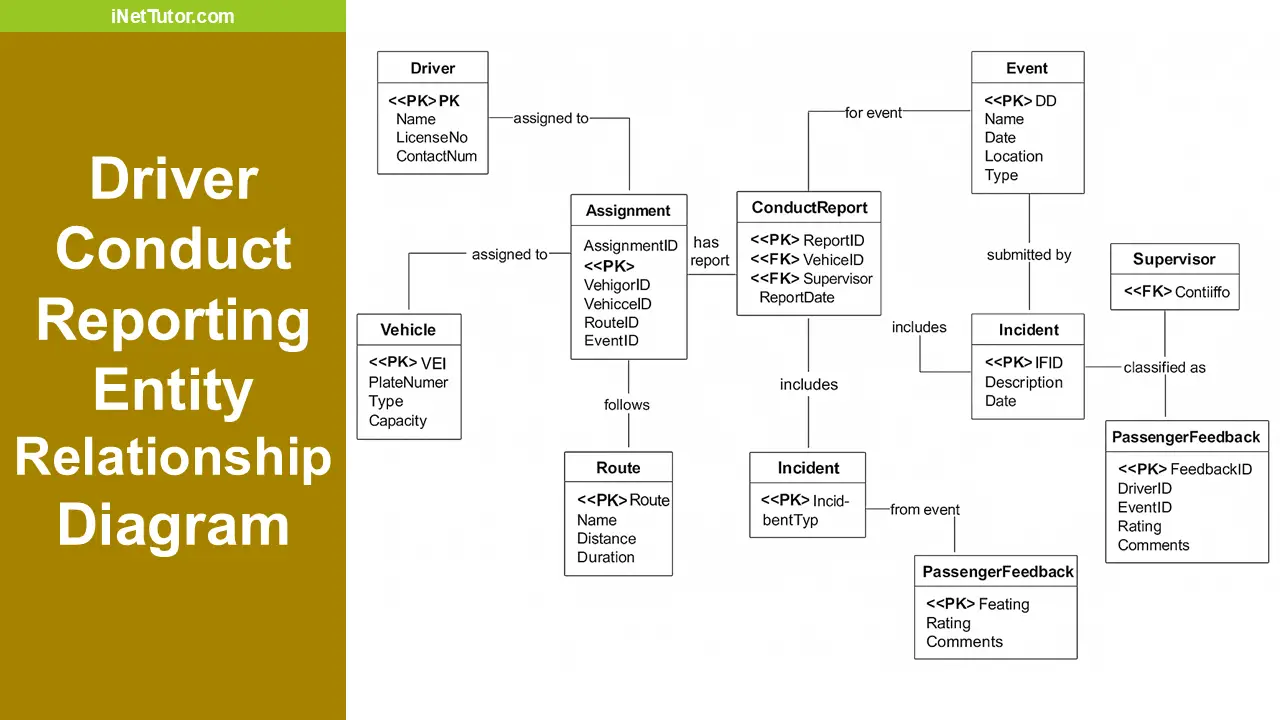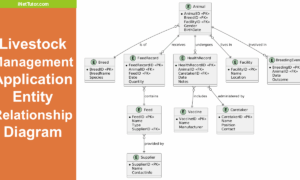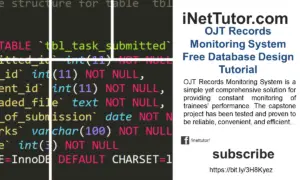Social Networking Application Conceptual Framework
This tutorial will walk you through the process of developing a conceptual framework for your capstone project, Social Networking Application. For the conceptual framework of this inquiry, the input, process, output (IPO) model was adopted.
About the Project
Table of Contents
The main reason which leads the developer into an idea of developing the system is the interaction for interaction is the essence of any social networking media. In the evolution of the state-of-the-art technologies, many systems have been developed and used by the society in order to enjoy, to live and even to influence others.
The development of a Social Networking Application involves a comprehensive process that requires a clear understanding of the problem, goals, and requirements of the application. A conceptual framework is a visual representation of these underlying relationships, concepts, and ideas that guide the development process. The purpose of the conceptual framework is to provide a roadmap for the development team, ensuring that the final product meets the needs and expectations of users.
The conceptual framework of a Social Networking Application typically includes a detailed analysis of the current social networking market, the needs and preferences of users, and the competitive landscape. It also includes a definition of the key features and functionalities of the application, such as the ability to create and manage user profiles, connect with friends and followers, share content and media, and participate in online communities.
The development process for a Social Networking Application typically involves a series of phases, including requirements gathering, design, development, testing, and deployment. The development team must work closely with stakeholders, such as users and stakeholders, to ensure that the application meets their needs and expectations. Additionally, the development team must consider the security and privacy of user data and implement appropriate measures to protect this data.
The system is essential to be pursued in view of the fact that the system will contribute a lot of help to the school’s improvement as it competes to other prestigious institutions in terms of the utilization of technology. The Researchers want to take advantage of the technology advancement in order to give the institution an identity.
Objectives of the Study
- To be able to determine the awareness on social networking system among students, faculty and staff.
- To enhance peer- to-peer relationship among the members of the system.
- To promote dissemination of information within the institution.
- To evaluate the feasibility of social networking system in the discharge of duties and responsibilities of personnel.
What is Conceptual Framework?
A Conceptual Framework is a visual representation of the underlying ideas, concepts, and relationships that form the basis of a research study. It is a map that outlines the key components and relationships between variables and theories, and provides a comprehensive overview of the research problem, goals, and objectives.
The importance of a conceptual framework in research lies in its ability to guide the research process and ensure that the study is grounded in a solid theoretical foundation. It helps researchers to understand the complex relationships between variables, theories, and concepts, and to make informed decisions about how to design and carry out their research. The conceptual framework also helps to ensure that the research is consistent, coherent, and well-structured, making it easier for other researchers to understand and replicate the study.
Moreover, a conceptual framework is an essential tool for developing and testing hypotheses and theories, as it provides a clear and comprehensive framework for examining the relationships between variables. It also helps to ensure that the research is guided by a well-defined set of objectives, and that the data collected is relevant and meaningful.
Conceptual Framework Diagram
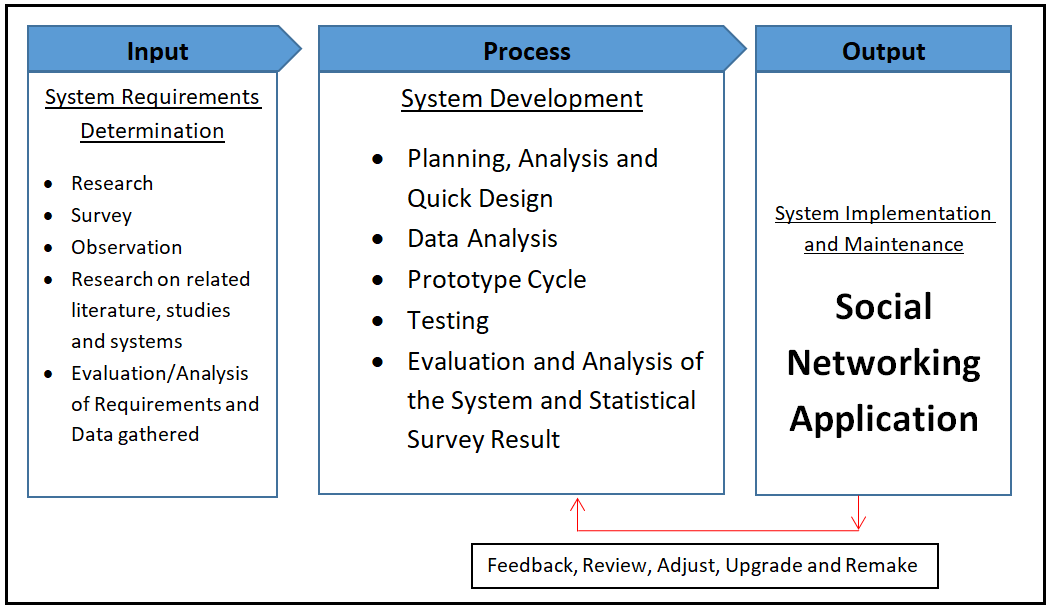
The image shown above is the Conceptual Framework Diagram of the Social Networking Application. The Conceptual Framework of the capstone project Social Networking Application is designed using the IPO Model.
Input
The project will begin by evaluating the present process, which will lead to the stage of doing research, survey and observation. The researchers will also need to compile relevant papers and systems to use as a guide for the project’s development. After all such process, the researchers will evaluate and analyze the requirements and data gathered.
Process
Analysis and Quick Design
During Analysis and Quick Design, the researchers did a personal interview with the respondents and the chosen client where the study was conducted. The respondents were given the chance to suggest how the system will be designed. After conducting the data gathering, the researchers made an initial design for the proposed system.
Data Analysis
The researchers will analyze all the data, user requirements and information. This phase also help the researchers to have an idea on how to create the system and have an idea on how the proposed system would be beneficial to the clients.
System Design
The researchers will start to develop the proposed system. It includes the design; how the system would look like based on user requirements, and the researchers/programmer would like to add personal design to make the system more interactive and user friendly.
Prototype Cycle
This stage will consist of the researchers’ data being compiled, built, demonstrated, and refined. The researchers create a prototype first, based on the planned design and data tables. The prototype will be shown to the client after it has been built. The researchers demonstrate the system’s operation, the flow of how it operates, and the functions of the system’s features. The next stage is refining, in which the researchers will fine-tune the system based on the client’s extra requirements. Changes to the features flow and functionalities will be made based on the needs.
Testing and Evaluation
This will include the feed backing of the proposed system after it will be implemented and had undergone testing by three Experts. It will also inform the researchers and the developer if there are any bugs, suggestion and if the system’s functionality will work well.
This will discuss the implementation of the proposed system wherein Three (3) Experts will evaluate the proposed system. This will also discuss if the recommended functions and suggestion are met.
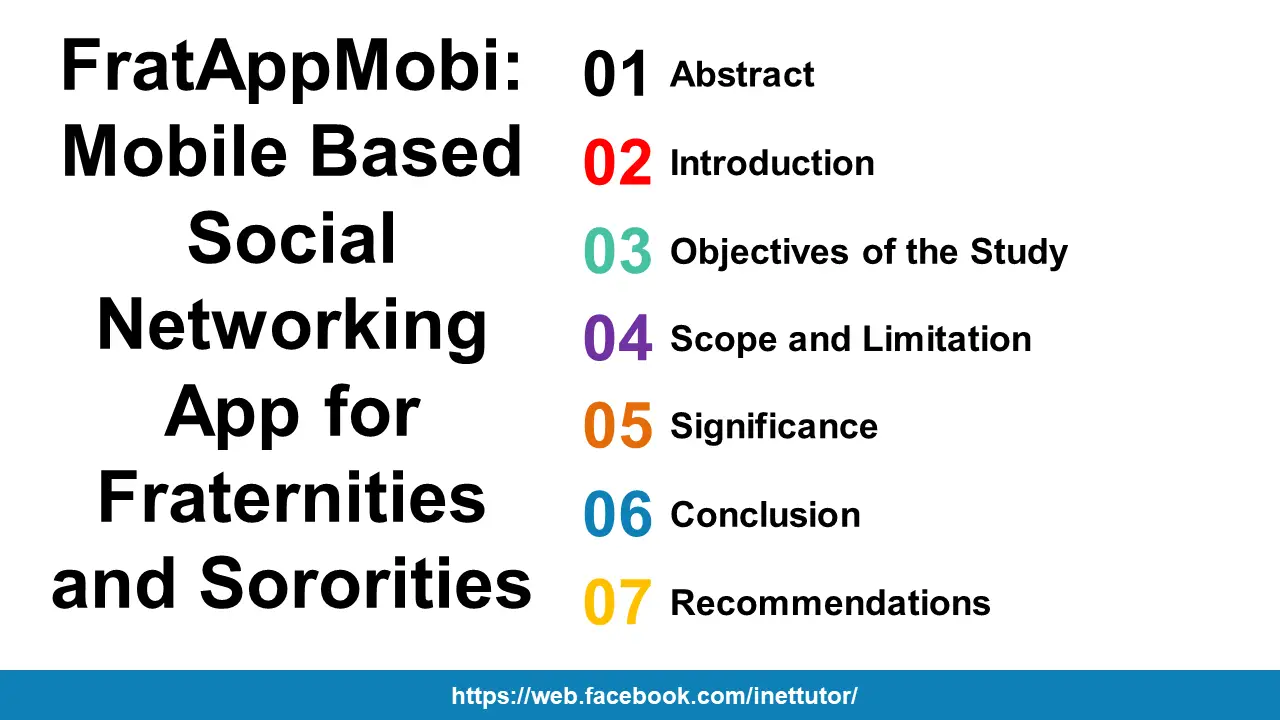
Output
The project comes to life and is executed in the real world after all of the necessary procedures have been completed. A new project is born, and it will be maintained for the project’s long-term survival. The Social Networking Application will be implemented and utilized.
A Social Networking Application is designed to provide users with a platform for connecting with friends and followers, sharing content and media, and participating in online communities. The outputs of a Social Networking Application include a range of functionalities and features, such as the ability to create and manage user profiles, connect with friends and followers, share content and media, and participate in online communities. These outputs are designed to meet the needs and preferences of users, and to provide a user-friendly and engaging experience.
The outcomes of a Social Networking Application are far-reaching and can have a significant impact on the lives of users. For example, the application can provide users with the opportunity to expand their social networks, connect with others who share similar interests and experiences, and participate in online communities. The application can also provide users with a platform for self-expression, as well as a means of staying in touch with friends and family, and staying informed about the latest news and trends. Additionally, the application can provide businesses and organizations with a platform for marketing and advertising, reaching a wider audience and engaging with customers and prospects in real-time.
In conclusion, the outputs and outcomes of a Social Networking Application are wide-ranging and can have a significant impact on the lives of users, as well as businesses and organizations. The application provides a platform for connecting with others, sharing content and media, and participating in online communities, and can provide a range of benefits, such as expanding social networks, staying informed, and engaging with customers and prospects.
Summary
This research article focuses on the conceptual framework diagram of the Social Networking Application. The input, process, and output (IPO) model serves as the conceptual framework for the investigation. The input phase includes Research, Survey, Observation, Research on related literature, studies and systems and Evaluation/Analysis of Requirements and Data gathered. When the input phase is finished, the researchers will move on to the process stage. The Software Development Life Cycle (SDLC) approach is employed (SDLC). The SDLC technique includes Planning, Analysis and Quick Design, Data Analysis, Prototype Cycle, Testing and Evaluation and Analysis of the System and Statistical Survey Result. The final stage before the developed system is implemented and used is the output phase. The researchers will be in charge of the newly formed venture.
Readers are also interested in:
Social Media App in Flutter and Firebird Free Source Code
Social Networking Website using WordPress and Buddy Press
You may visit our Facebook page for more information, inquiries, and comments. Please subscribe also to our YouTube Channel to receive free capstone projects resources and computer programming tutorials.
Hire our team to do the project.
